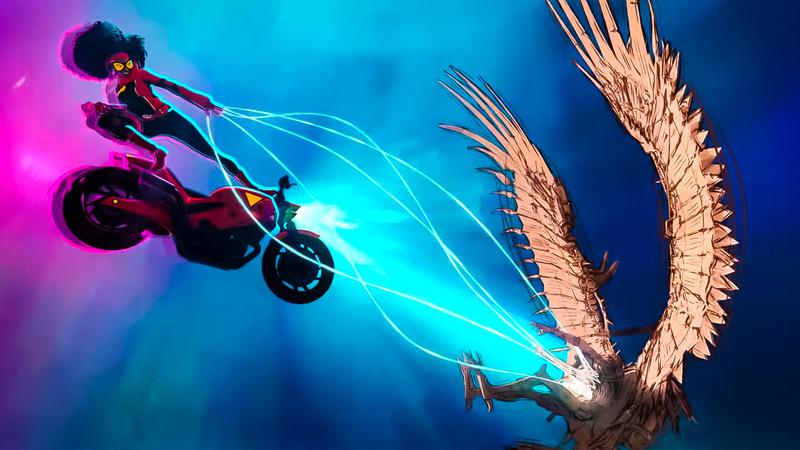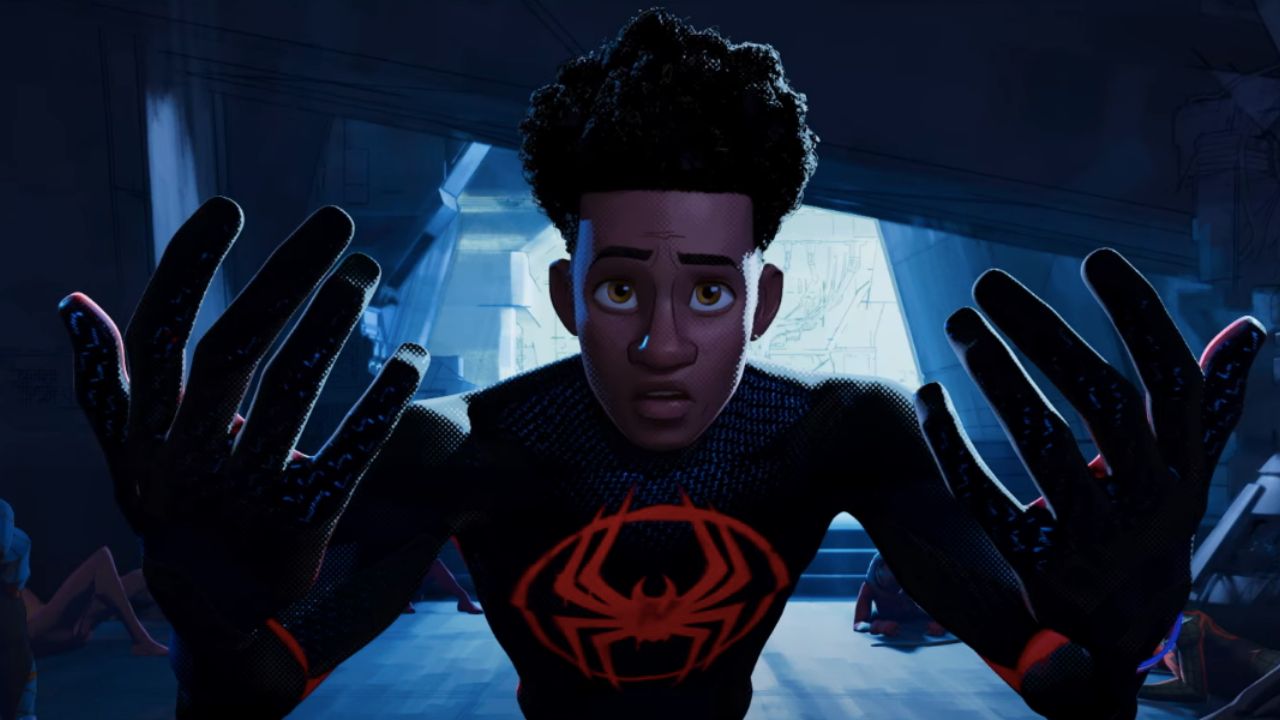When a film throws at you exuberant colours, a dozen different animation styles, all sorts of metaphysical conundrums, unexpected plot machinations galore, and some of the best cultural representation in mainstream entertainment today, is it A) a thrilling example of the potential of the movies, or B) totally exhausting? The answer is actually C) both of the above. Spider-Man: Across the Spider-Verse is as much a feast for the eyes and ears as its 2018 predecessor – replace Across with Into for that film’s title – but the one thing it can’t replicate is showing us this crazy extravaganza for the very first time. And without that absolute whiz-bang thrill of the new, Across the Spider-Verse has to rely more heavily on its story to carry us the second time – with mixed results.
Since a third movie in this series – subtitled Beyond the Spider-Verse – is due in cinemas less than a year from now, it’ll be no surprise to anyone that Across the Spider-Verse is structured as the middle movie of a trilogy. That worked great for The Empire Strikes Back, maybe less so for The Matrix: Reloaded. That second point of comparison is particularly apt for Across the Spider-Verse. There may not be a scene of some architect ponderously explaining the deeper recesses of this rabbit hole until you’re begging him to stop, but Across the Spider-Verse does get a bit up its own arse. And there’s no doubt we may finally be succumbing to multiverse fatigue after all the cinema we’ve consumed these past five years, ever since the concept seemed pretty novel in Spider-Man: Into the Spider-Verse.
There’s enough plot and character in this 140-minute movie that a review encouraging you to see it can only ever really scratch its surface. But what you need to know about Across the Spider-Verse starts with the characters who were central to the original – not only Miles Morales (Shameik Moore), who inherited the role of Spider-Man after the death of his dimension’s Peter Parker, but his best friend/love interest Gwen Stacy (Hailee Steinfeld), who has alternately been known as Spider-Woman and Spider-Gwen.
In her own timeline and on her own Earth, Gwen has been hitting the key beats of the standard Spider-Hero adventure – more on that in a minute – which have included the death of her own Peter Parker, who in this universe drank a potion to become the Lizard, and ultimately, to be defeated in battle by Gwen. That death was dubbed a murder by police captain George Stacy (Shea Whigham), who doesn’t know it’s his daughter under that mask, and is pursuing a vigilante who lives under his own roof.
Gwen won’t be in this timeline for long. An alternate version of the Vulture from some Da Vinci-inspired Earth crashes into her reality, and is followed closely by Miguel O’Hara (Oscar Isaac), a Spider-Man who has assigned himself and his team the task of collecting up all the creatures displaced into different timelines by the destruction of the Alchemex collider at the end of the previous movie. To escape a father who has turned his back on her, Gwen reluctantly joins Miguel and his team on the mission.
Meanwhile, Miles has his own Earth – it’s called Earth-1610, in a naming convention familiar to us after Doctor Strange in the Multiverse of Madness, though there “our” Earth was #616. Yes it’s all very confusing. He’s in his first year of daily Spider-Man activities, which always make him late for some appointment or a party to honour his father (Brian Tyree Henry) on the eve of his promotion to police captain. After his prior exposure to all the other alternate Spider-Heroes, Miles is lonely with no one around to understand him – so the arrival of Gwen is well timed. She’s overdue for a visit, but since we know she just picked up with the overly serious Miguel and his compatriots, we also know her presence has an ulterior motive.
The threat comes from a character who is first introduced as a bit of a joke, who calls himself The Spot (Jason Schwartzman) and looks like Rorschach from Watchmen except that the blotches on his face and body are actual portals. We meet him when he’s haplessly trying to stuff a convenience store ATM into one of his body portals, but he quickly undergoes the sort of transformation that might make him what he really wants to be: Miles Morales’ nemesis, whose goal will be to take everything Miles has, and also probably destroy the Spider-Verse in the process.
It took three credited directors to wrestle Into the Spider-Verse into existence, and it takes another three here, though they are a different three. Joaquim Dos Santos, Kemp Powers and Justin K. Thompson are matched on the screenwriting side by a second trio: Phil Lord, Christopher Miller and David Callaham. If any film required so many cooks in the kitchen, it’s certainly an epic, ambitious and frenetic film like this one. And that’s even before you get into the numerous creative minds who had to master the inimitable look of these films, which have the dappled pages of comic books but are also synergising animation styles from throughout the history of the medium. (Are there Legos in this movie? Yes there are.)
It’s impossible to imagine nothing getting lost in all this shuffle, and indeed, it’s easy to see the points where this suffers as either a cohesive narrative or a propulsive one. There are times, particularly in the first 20 minutes, when too much is happening on screen at once, the dialogue that’s trying to explain it getting lost in the general confusion. Then there are stretches with Miles and his family that seem like they are needlessly elongated, duplicating story beats for little purpose and contributing to the protracted running time. More problematic in terms of the film’s distended length, though, is the fact that it feels like it might be wrapping up for about 30 minutes before it actually ends, in a notable example of “Lord of the Rings: Return of the King Syndrome.”
When everything is as ecstatic and stupendously unbelievable to look at as this, what’s an extra 20 minutes? You do feel it, and the film creates problems for itself the more it steps outside itself to look at itself as a construct. There are lots of winks to actual or potential incarnations of Spider-Man – in fact, Donald Glover has a cameo to acknowledge his flirtation with playing a live-action version of Miles – and a central part of the story comes to revolve around “canon events” in the Spider-Man narrative. That’s right, the film becomes fixated on the idea that these many parallel realities in the Spider-Verse can only properly exist if certain foundational narrative beats occur – like, every Spider-Man needs to have an equivalent of Uncle Ben’s death. Or else.
Yeah it’s clever enough, and is not a significant deviation from the way other popular entertainments have invited audiences to see the product as self-aware, making them privy to insider information and thereby rewarding them for their close readings. And after quite a long time of albeit exhilarating water treading, Across the Spider-Verse does end on its most interesting surprise.
But it’s equally possible to walk out of Spider-Man: Across the Spider-Verse feeling very, very tired. The fatigue is real. Whether it’s fatigue of the multiverse specifically, fatigue of superhero movies generally, or just even further generalised fatigue of spectacles that run well over two hours, it isn’t really a feeling you want to have on your way out of the cinema. Nor do you want to acknowledge that something is an incredible achievement and yet you also can’t imagine watching it a second time.
Spider-Man: Across the Spider-Verse is currently playing in cinemas.




